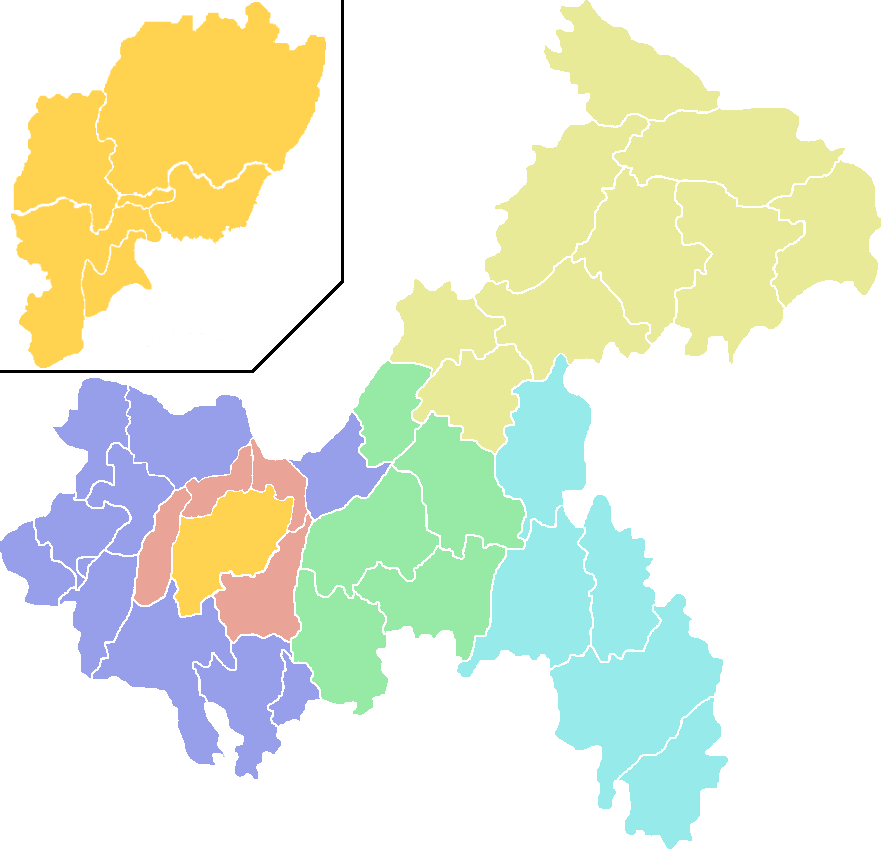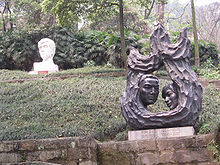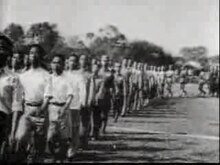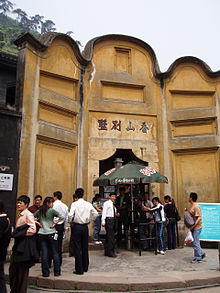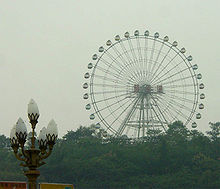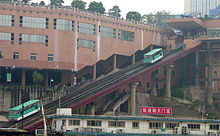Chongqing
| Chóngqìng Shì 重庆 市 Chongqing |
|
|---|---|
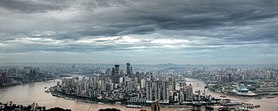 Chongqing skyline, 2010 |
|
| Coordinates | 29 ° 33 ' N , 106 ° 34' E |
 Location of Chongqing in China |
|
| Basic data | |
| Country | People's Republic of China |
| region | Southwest China |
| Government immediate city | Chongqing |
| ISO 3166-2 | CN-CQ |
| status | Government immediate city |
| structure | 26 urban districts, 8 districts, 4 autonomous districts, 557 large municipalities, 272 municipalities, 160 street districts, 14 nationality municipalities |
| height | 243 m |
| surface | 82,403 km² ( 26. ) |
| Residents | 28,846,170 (2010) ( 20. ) |
| density | 350.1 Ew. / km² |
| Post Code | 400000-409900 |
| Time zone | China Standard Time (CST) UTC +8 |
| Website | www.cq.gov.cn |
| politics | |
| mayor |
Tang Liangzhi 唐良智 |
Chongqing ( Chinese 重慶 市 / 重庆 市 , Pinyin Chóngqìng Shì , W.-G. Ch'ung-ch'ing Shih , without diacritical Chungching Shih , obsolete after Post Chungking or Stange Tschungking , abbrev .: 渝 , yú , Jyutping jyu 4 ) is a metropolis in the People's Republic of China at the confluence of the Yangtze and Jialing rivers .
As a city under direct government control, Chongqing represents an independent administrative unit with 30.48 million inhabitants (end of 2016). If only the administrative city limits are used, Chongqing is the largest city in the world in terms of population. At 82,403 square kilometers, the area of the city's administrative area is almost as large as the state of Austria and consists mainly of areas with a rural settlement structure. If the core city (high density of buildings and closed local form) is taken as the basis, 6.6 million people live in Chongqing. The metropolitan area (including suburbs) has 19.1 million inhabitants (2016). The urban agglomeration was estimated by the UN to have 14.3 million inhabitants in 2017 .
The city, which is directly governed by the government, was created on March 14, 1997 by separating from the eastern part of Sichuan Province and incorporating the surrounding greater region. The city is the industrial center, transport hub and cultural center of the region with universities, colleges, theaters, museums and galleries. Consulates general from Great Britain and Japan as well as consulates from Denmark, Cambodia, Canada and the Philippines are based in the city.
geography
Geographical location
The city of Chongqing was built at the confluence of the Jialing and the Yangtze . The location on the eastern edge of the Red Basin , the “rice bowl” of China, has favored the city's growth. However, the great distance to the coast and especially the difficult accessibility have hindered development in the past. The reservoir formed by the Three Gorges Dam extends as far as Chongqing so that larger ships can reach the city.
The city is surrounded by mountains: the Daba Shan in the north, the Wu Shan in the east and the Dalou Shan in the south. Since Chongqing was built on very hilly terrain, the streets are sometimes very steep, which is expressed in the name "City of Mountains" (Shancheng) . It is an average of 243 meters above sea level .
The administrative urban area of Chongqing extends 470 kilometers in an east-west direction and 450 kilometers in a north-south direction. It has an area of 82,402.95 square kilometers, which roughly corresponds to the floor area of Austria. Of this, 1,472.55 square kilometers (1.79%) belong to the core city (high building density and closed local form) and 80,930.4 square kilometers (98.21%) to areas with a predominantly rural settlement structure. The metropolitan area has an area of 9,622.83 square kilometers.
Neighboring provinces are Hubei and Hunan in the east, Guizhou in the south, Sichuan in the west and Shaanxi in the north . Around 80 rivers flow through the administrative area of the government-direct city of Chongqing. The largest are the Yangtze, Jialing, Wu Jiang , Fu Jiang , Qi Jiang and Daning He .
geology
Chongqing is located in the Red Basin , a basin landscape traversed by the Yangtze River and fertile, hilly hill country made up of mostly red sandstones and clays, which is surrounded by higher mountain ranges. The Red Basin is rich in mineral resources (coal deposits, ores, salt, petroleum and phosphorus). Chongqing hit the headlines after the Chuandongbei gas explosion on December 25, 2003, when a gas well exploded in the Chuandongbei gas field when a large amount of toxic gases suddenly escaped, killing 191 people and injuring an estimated 4,000 to 5,000 people, some seriously .
In the northwest of the basin lies the alluvial plain of Chengdu . The approximately 800 kilometers long, rapids-rich Yangtze River breaks through the mountain ranges that bulge at the Chinese relay break and seal off the Red Basin from eastern central China.
City structure and population
Downtown
Downtown Chongqing is divided into six boroughs. These are:
- District Yuzhong ( 渝中区 , Yuzhong Qū ), the actual city
- District Dadukou ( 大渡口区 , Dadukou Qū )
- Nan'an District ( 南岸 区 , Nán'ān Qū ),
- District Jiulongpo ( 九龙坡区 , Jiǔlóngpo Qū )
- District Shapingba ( 沙坪坝区 , Shapingba Qū )
- District Jiangbei ( 江北区 , Jiangbei Qū ).
The so-called "New District" Liangjiang ( 两 江 新区 , Liǎngjiāng Xīnqū ), founded on June 18, 2010, comprises parts of the Jiangbei , Yubei and Beibei districts with a total area of approx. 1,200 km². In contrast to comparable start-ups in Tianjin ( Binhai ) and Shanghai ( Pudong ), this is a pure measure to promote economic development, i.e. H. Liangjiang is not a city district in the administrative sense. It is not administered by a “people's government”, but by the “leadership group for the development and development of the Liangjiang New District” (两 江 新区 开发 建设 领导 小组Liangjiang Xinqu kaifa jianshe lingdao xiaozu ), which is made up of representatives from the city of Chongqing and the affected boroughs. Accordingly, the three city districts mentioned will remain in their previous administrative boundaries with their people's governments and the associated political structures (people's congresses, consultative conferences), at least for the time being.
The following table contains the population figures determined in the November 1, 2000 and November 1, 2010 censuses. The residents whose main residence is in Chongqing are listed. Since on October 22, 2011 the former Shuangqiao district was merged with the previous district to form the new city district, the former district of Wansheng and the former district of Qijiang to form the new city district of Qijiang, the area and population figures for the new city districts must be added.
| Municipality or county |
chin. | Area [km²] |
Population (2000) |
Population (2010) |
Ew./km² (2010) |
location |
|---|---|---|---|---|---|---|
| Banana | 巴南 | 1,830.30 | 886.447 | 918,692 | 501.9 | edge |
| Besides | 北碚 | 755.42 | 646,577 | 680.360 | 900.6 | edge |
| Bishan | 璧山 | 912.41 | 608.473 | 586.034 | 642.3 | edge |
| Changshou | 长寿 | 1,415.49 | 874.307 | 770.009 | 544.0 | Surrounding area |
| Chengkou | 城 口 | 3,286.00 | 225,581 | 192.967 | 58.7 | Wanzhou |
| Dadukou | 大 渡口 | 94.39 | 247.021 | 301.042 | 3,189.3 | Inside |
| To | 大 足 | 1,390.21 | 905.409 | 671.243 | 482.8 | Surrounding area |
| Dianjiang | 垫江 | 1,518.00 | 862.323 | 704.458 | 464.1 | Rg.Fuling |
| Fengdu | 丰都 | 2,901.00 | 774.054 | 649.182 | 223.8 | Rg.Fuling |
| Fengjie | 奉节 | 4,087.00 | 871.743 | 834.259 | 204.1 | Wanzhou |
| Fuling | 涪陵 | 2,946.00 | 1,134,080 | 1,066,714 | 362.1 | Rg.Fuling |
| Hechuan | 合川 | 2,356.21 | 1,420,520 | 1,293,028 | 548.8 | Surrounding area |
| Jiangbei | 江北 | 213.52 | 609.619 | 738.003 | 3,456.4 | Inside |
| Jiangjin | 江津 | 3,200.22 | 1,322,890 | 1,233,149 | 385.3 | edge |
| Jiulongpo | 九龙坡 | 443.03 | 878.777 | 1,084,419 | 2,447.7 | Inside |
| Kaizhou | 开 州 | 3,959.00 | 1,408,116 | 1,160,336 | 293.1 | Wanzhou |
| Liangping | 梁平 | 1,890.00 | 850.064 | 687.525 | 363.8 | Wanzhou |
| Nan'an | 南岸 | 278.78 | 592,566 | 759,570 | 2,724.6 | Inside |
| Nanchuan | 南川 | 2,602.00 | 631.853 | 534.329 | 205.4 | Rg.Fuling |
| Pengshui | 彭水 苗族 | 3,903.00 | 590.228 | 545.094 | 139.7 | southeast |
| Qianjiang | 黔江 | 2,397.00 | 442,385 | 445.012 | 185.7 | southeast |
| Qijiang | 綦江 | 2,182.14 | 962.813 | 801.041 | 367.1 | Surrounding area |
| Rongchang | 荣昌 | 1,079.01 | 659.556 | 661.253 | 612.8 | Surrounding area |
| Shapingba | 沙坪坝 | 383.45 | 789.359 | 1,000,013 | 2,607.9 | Inside |
| Shizhu | 石柱 | 3,013.00 | 484.876 | 415.050 | 137.7 | southeast |
| Shuangqiao | 双桥 | 37.48 | 42,033 | 50.116 | 1,337.1 | Surrounding area |
| Tongliang | 铜梁 | 1,341.73 | 794.104 | 600.086 | 447.3 | Surrounding area |
| Tongnan | 潼南 | 1,584.97 | 860.016 | 639.985 | 403.8 | Surrounding area |
| Wansheng | 万盛 | 565.58 | 265,743 | 255.776 | 452.2 | Surrounding area |
| Wanzhou | 万州 | 3,457.00 | 1,648,870 | 1,563,050 | 452.1 | Wanzhou |
| Wulong | 武隆 | 2,901.00 | 397.697 | 351.038 | 121.0 | Rg.Fuling |
| Wushan | 巫山 | 2,958.00 | 571,959 | 495.072 | 167.4 | Wanzhou |
| Wuxi | 巫溪 | 4,030.00 | 483,759 | 414.073 | 102.7 | Wanzhou |
| Xiushan | 秀山 | 2,450.00 | 507,522 | 501,590 | 204.7 | southeast |
| Yongchuan | 永川 | 1,575.68 | 984.730 | 1,024,708 | 650.3 | Surrounding area |
| Youyang | 酉阳 | 5,173.00 | 594.287 | 578.058 | 111.7 | southeast |
| Yubei | 渝北 | 1,452.03 | 843,482 | 1,345,410 | 926.6 | edge |
| Yunyang | 云阳 | 3,649.00 | 1,219,647 | 912.912 | 251.2 | Wanzhou |
| Yuzhong | 渝中 | 21.90 | 664.942 | 630.090 | 28,771.2 | City |
| Zhong | 忠 | 2,184.00 | 954.075 | 751.424 | 334.1 | Wanzhou |
| Chongqing | 重庆 市 | 82,402.95 | 30,512,763 | 28,846,170 | 350.1 |
Periphery
The outskirts of the city center include four districts:
- Banan District (巴南 区Bānán Qū ),
- Beibei District (北碚 区Běibèi Qū ),
- District Yubei (渝北区Yubei Qū )
- Bishan District (璧山 区Bìshān Qū ).
Rural environment
Nine city districts are in the rural area outside the city center:
- District Changshou (长寿区changshou Qū )
- Hechuan District (合川 区Héchuān Qū ),
- Jiangjin District (江津 区Jiāngjīn Qū ),
- Yongchuan District (永川 区Yǒngchuān Qū ),
- City District Addition (大 足 区Dàzú Qū ),
- District QIJIANG (綦江区QIJIANG Qū )
- Rongchang District (荣昌 区Róngchāng Qū ),
- Tongliang Municipality (铜梁 区Tóngliáng Qū ),
- Tongnan Municipality (潼南 区Tóngnán Qū ).
Fuling
The region of Fuling (涪陵 专区Fúlíng Zhuānqū ) borders the city center to the east and consists of three districts and two counties:
- Fuling District (涪陵 区Fúlíng Qū ),
- District Nanchuan (南川区Nanchuan Qū )
- Wulong District (武隆 区Wǔlóng Qū ),
- Dianjiang County (垫江 县Diànjiāng Xiàn ),
- District Fengdu (丰都县Fengdu Xiàn ).
Wanzhou
The Wanzhou region is located far northeast of Chongqing proper. It consists of three boroughs and six districts:
- Wanzhou District (万州 区Wànzhōu Qū ),
- District Kaizhou (开州区Kaizhou Qū )
- Liangping District (梁平 区Liángpíng Qū ),
- Circle Chengkou (城叢县Chéngkǒu Xiàn )
- Fengjie County (奉节 县Fèngjié Xiàn ),
- Yunyang County (云阳 县Yúnyáng Xiàn ),
- District Wushan (巫山县Wushan Xiàn )
- Wuxi County (巫溪 县Wūxī Xiàn ),
- Zhong County (忠县Zhōng Xiàn ).
Qianjiang
The Qianjiang region (黔江 地区Qiánjiāng Dìqū ) adjoins that of Fuling to the east and forms the southeast of the Chongqing area. It is divided into a city district and four autonomous counties:
- Qianjiang District (黔江 区Qiánjiāng Qū ),
- Pengshui Autonomous County of the Miao and Tujia (彭水 苗族 土家族 自治县Péngshuǐ Miáozú Tǔjiāzú Zìzhìxiàn ),
- Shizhu Autonomous County of the Tujia (石柱 土家族 自治县Shízhù Tǔjiāzú Zìzhìxiàn ),
- Xiushan Autonomous County of Tujia and Miao (秀山 土家族 苗族 自治县Xiùshān Tǔjiāzú Miáozú Zìzhìxiàn ),
- Youyang Autonomous County of the Tujia and Miao (酉阳 土家族 苗族 自治县Yǒuyáng Tǔjiāzú Miáozú Zìzhìxiàn ).
Autonomous circles
The four autonomous counties are included in the rest of the structure, but are also listed here again: Pengshui Autonomous County of the Miao and Tujia (彭水 苗族 土家族 自治县Péngshuǐ Miáozú Tǔjiāzú Zìzhìxiàn ), Shizhu Autonomous County of the Tujia (石柱 土家族 自治县Shízhù Zizhixian ) Autonomous district Xiushan the Tujia and Miao (秀山土家族苗族自治县Xiushan Tǔjiāzú Miáozú Zizhixian ) and the Autonomous circuit Youyang the Tujia and Miao (酉阳土家族苗族自治县Yǒuyáng Tǔjiāzú Miáozú Zizhixian ).
climate
Chongqing is located in the subtropical climate zone . The annual average temperature is 19.0 degrees Celsius. The average annual rainfall is 1138 millimeters, of which about 69 percent fall in the months May to September.
The climate of Chongqing is characterized by short and relatively mild winters and hot and humid summers. From October to April there is a very high humidity with often thick fog: this is the name of the “fog capital” (Wudu) . Because of its inland location, Chongqing has distinct dry and rainy periods. The warmest month is August with a maximum of 32.8 degrees Celsius and a minimum mean daytime temperature of 24.5 degrees Celsius. The extreme values sometimes reach up to 40 degrees Celsius. The coldest month in the Chongqing area is January with a maximum of 9.5 degrees Celsius and a minimum of 5.6 degrees Celsius daily mean temperature.
In the summer of 2006, Chongqing suffered a severe drought. It didn't rain for weeks and most of the rivers dried up. According to state data, it was the worst drought in decades in China. The highest temperature was officially measured on August 15, 2006 at the weather station in Qijiang at 44.5 degrees Celsius. The previous record was 44.1 degrees Celsius, measured on August 19, 1953 at the weather station in Pengshui.
Heavy rains caused flooding in Chongqing in the summer of 2007. On July 18, 2007, at 266.6 millimeters in one day, the highest amount of precipitation since weather records began in 1892 was measured. The previous record was 206.1 millimeters of precipitation, measured on July 21, 1996.
|
Average monthly temperatures and rainfall for Chongqing
Source: wetterkontor.de
|
|||||||||||||||||||||||||||||||||||||||||||||||||||||||||||||||||||||||||||||||||||||||||||||||||||||||||||||||||||||||||||||||||||||||||||||||||||||||||||||||||||||
history

Prehistoric finds indicate the existence of the Tongliang culture in the area of later Chongqing. Bones were with the radiocarbon method at an age of about 25,000 years dated . According to tradition, King Yu, founder of the legendary Xia dynasty and tamer of the floods, found a wife here and founded the city. In prehistoric times, the region was divided into the kingdoms of Ba in the east and Chu in the west, which were united during the (first historically documented) Shang Dynasty (1700–1100 BC). Around 1000 BC Chr. Chongqing was already the capital of the state Ba. Excavations at Sanxingdui, near Chengdu, suggest that the Ba-Chu society was based on slavery and not only reached a high level of development in metalworking, but also stood out for its bizarre aesthetics.
Thanks to new cultivation methods, the east of Sichuan - today's administrative area of the government-direct city of Chongqing - developed towards the end of the 3rd century BC. To an agriculturally intensively used region. When the Qin armies invaded the country, they found an economic base that gave them 221 BC. The unification of the Chinese Empire made possible.
The current name means something like "double celebration" and was given to Chongqing by its resident Zhao Dun ( Chinese 趙 惇 , Pinyin Zhào Dūn ) when he was named Prince of Gongzhou, the former name of Chongqing, in quick succession and then 1189 when Guangzong ( Chinese 光宗 , Pinyin Guāngzōng ) ascended the throne of the Emperor of the Song Dynasty . The city looks back on a long tradition as a fortress against enemy invaders . From 1242 to 1278, in Hechuan, 60 kilometers north of Chongqing, the Song forces held the Mongol armies in check. It was the longest uninterrupted campaign on Chinese soil.
During the Yuan dynasty , the rebel leader Ming Yuzhen established the brief kingdom of Daxia in Chongqing in 1362. The Daliang Kingdom, founded in the Chongqing area in 1621, was also short-lived. In the 18th and 19th centuries, the Hu-Guang Huiguan was built in Chongqing as a meeting place primarily for merchants. In 1891, as part of the open door policy , Chongqing was the first inland port in China to be forcibly opened as a " contract port " for foreign trade under pressure from Great Britain and Japan .
In 1911, foreign governments started the Xinhai Revolution , which led to the collapse of the Chinese Empire . In the following four decades ("warlords" ( Chinese 民国 军阀 )) rival military rulers fought for local supremacy. Some of the nominally independent states they founded in the region existed until 1955. After Chinese reunification , Chongqing received the status of an independent city at the provincial level in 1929.
During the Sino-Japanese War , the government of the Republic of China, led by Chiang Kai-shek, withdrew to Chongqing after the Nanking massacre . The town, which then had half a million inhabitants, became the war capital of China until the end of the Second World War . Between February 18, 1938 and August 23, 1943 there were numerous Japanese air raids on Chongqing , killing more than 10,000 civilians. In Hongyan , a suburb of Chongqing, the Second United Front established its headquarters on August 12, 1938 . This alliance between national Chinese and Chinese communists lasted until 1946.
In Hongyan, Mao Zedong and Chiang Kai-shek met the US Ambassador Patrick Hurley in August 1945 . The latter had the thankless task of informing the national Chinese and Chinese communists about the results of the Yalta Conference, which had now come into force , at which Chinese territorial cession had been assured by the Soviet Union in a secret agreement. The determined anti-communist Hurley stood on the side of the national Chinese, but foresaw the end of a non-communist China through the Soviet expansion of territory and special rights. The events of Hongyan in 1946 led to the open continuation of the Chinese Civil War .
On November 30, 1949, the communists captured Chongqing, the penultimate mainland base of the national Chinese. Chengdu , the last mainland base, fell on December 10, 1949. In 1954, Chongqing was united with Sichuan Province and given the status of a district-free city (dijishi) .
In the mid-1970s, Sichuan’s economy and agriculture emerged from the period of the Cultural Revolution, badly hit. Among other things, Sichuan was the first province to abandon Mao Zedong's communist policy when party leader Zhao Ziyang first allowed farmers to sell their produce on the free market. He thus formed the basis for the later reforms of Deng Xiaoping , who also came from Sichuan. These and other reforms proved to be so effective that the province often preceded market reforms and was able to establish itself as a serious competitor to the east coast economy as early as the 1990s.
Chongqing, the already heavily industrialized link on the Yangtze River between Sichuan and eastern China, played a major role in this development . In 1983, the city was granted provincial economic management rights, and in 1992, Chongqing City Council declared Chongqing the first open city on the Yangtze River. Chongqing's economic weight ensured the city a special status in the following years. On March 14, 1997, by resolution of the National People's Congress, the eastern part of Sichuan Province was merged into the government-direct city of Chongqing and the cities of Wanxian and Fuling Chongqing were annexed. This created an administrative area the size of the State of Austria , which is also the largest city in the world in terms of its number of inhabitants.
In the meantime, the development of the region continues and brings with it all the side effects of rapid growth: high air pollution , conversion of agricultural and forestry areas into building land and increasing construction activity. The peninsula and the growing suburbs and industrial areas that extend inland from the river are densely populated. The region is considered to be the "spearhead" of western China's development. Many of the 1.4 million people who were relocated when the Three Gorges Dam was built by 2007 live in Chongqing.
Almost all of the historic houses in the mountain town , which is built on steep hills and surrounded by the same kind of hill town , as Chongqing is sometimes called by the locals, have been replaced by new ones since 1949. The city center mainly consists of concrete and glass buildings as well as numerous office complexes. The most famous nail house in China stood in Chongqing, and its press photo went around the world. The owners refused to vacate the building for a new build for two years. The construction company has already switched off the water and energy connections, excavated a ten-meter-high excavation around the building and closed the entire area. The owners "recaptured" the building, hoisted the Chinese flag on the roof and enjoyed great sympathy among the Chinese population.
Between mid-2010 and the end of 2011, resident rights were extended to around 3 million migrants from the rural hinterland. This reform does not abolish the Hukou system of residence entitlement, but extends the privileges to all residents of the region.
Population development

Between 1949 and 1990, Chongqing experienced rapid population growth. The population has tripled from one million to three million. 6.2 million people (2010) live in the core city (high density of buildings and closed locality). The population density is 4242 inhabitants per square kilometer. In comparison, there are 3800 in Berlin . The Chongqing metropolitan region has 7.7 million inhabitants (2007). The population density is 797 inhabitants per square kilometer. 28.8 million people (2010) live in the wider administrative urban area. The population density is 350 inhabitants per square kilometer.
The following overview shows the population of the core city (excluding the suburbs). The registered residents with main residence in Chongqing are listed.
|
|
Population development of the agglomeration according to the UN
In 2017, just under 14.3 million people lived in the actual urban agglomeration of the city. The rest of the population lives in the rural area. Due to advancing urbanization, 20.5 million inhabitants are expected in the agglomeration by 2035.
| year | population |
|---|---|
| 1950 | 1,567,000 |
| 1960 | 2,275,000 |
| 1970 | 2,237,000 |
| 1980 | 2,961,000 |
| 1990 | 4,011,000 |
| 2000 | 7,863,000 |
| 2010 | 11,244,000 |
| 2017 | 14,332,000 |
politics
City government
The Lord Mayor of Chongqing is Huang Qifan . He took over from his predecessor Wang Hongju in 2009 . Sun Zhengcai , also a member of the Politburo , has been Secretary of the Party Committee since November 2012 . He replaced Zhang Dejiang , who in March 2012 had replaced Bo Xilai, who had been recalled by the Central Committee of the Chinese Communist Party, on an interim basis .
The city government is subordinate to the governments of 19 city districts , 17 districts and four autonomous districts. The city districts are in turn divided into street quarters , partly into municipalities and large municipalities . Counties and autonomous counties, on the other hand, are predominantly made up of municipalities and large municipalities, while street districts occur in only a few counties that have developed an urban center. At the lower end of the administrative pyramid of Chongqing are the so-called communities of residents (社区) in the urban areas , which are administered by the residents' committees (居民委员会jūmín wěiyuánhùi ) and in the rural regions the villages (村), which are managed by village committees ( 村民委员会cūnmín wěiyuánhùi ) to get managed.
Partnerships
Chongqing has partnerships with the following cities and regions:
-
 Toulouse , France , since 1982
Toulouse , France , since 1982 -
 Seattle , USA , since 1983
Seattle , USA , since 1983 -
 Toronto , Canada , since 1986
Toronto , Canada , since 1986 -
 Hiroshima , Japan , since 1986
Hiroshima , Japan , since 1986 -
 Voronezh , Russia , since 1993
Voronezh , Russia , since 1993 -
 Leicester , Great Britain ; Since 1993
Leicester , Great Britain ; Since 1993 -
 Zaporizhia Oblast , Ukraine , since 2002
Zaporizhia Oblast , Ukraine , since 2002 -
 Mpumalanga Province , South Africa , since 2002
Mpumalanga Province , South Africa , since 2002 -
 Düsseldorf , Germany , since 2004
Düsseldorf , Germany , since 2004 -
 Shiraz , Iran , since 2005
Shiraz , Iran , since 2005 -
 Aswan , Egypt , since 2005
Aswan , Egypt , since 2005 -
 Brisbane , Australia , since 2005
Brisbane , Australia , since 2005 -
 Incheon , South Korea , since 2007
Incheon , South Korea , since 2007 -
 Sør-Trøndelag , Norway , since 2007
Sør-Trøndelag , Norway , since 2007 -
 Chiang Mai , Thailand , since 2008
Chiang Mai , Thailand , since 2008 -
 Cordoba Province , Argentina , since 2010
Cordoba Province , Argentina , since 2010 -
 Budapest , Hungary , since 2010
Budapest , Hungary , since 2010 -
 Bangkok , Thailand , since 2011
Bangkok , Thailand , since 2011 -
 Antwerp , Belgium , since 2011
Antwerp , Belgium , since 2011 -
 Bahia , Brazil , since 2011
Bahia , Brazil , since 2011 -
 Canton of Zurich , Switzerland , since 2013
Canton of Zurich , Switzerland , since 2013 -
 Nuevo León state , Mexico , since 2013
Nuevo León state , Mexico , since 2013 -
 Phnom Penh , Cambodia , since 2014
Phnom Penh , Cambodia , since 2014 -
 Chennai , India , since 2015
Chennai , India , since 2015
In addition, individual city districts maintain partnerships with the following cities and regions:
-
Wanzhou : Gers department , France , since 1988

-
Wanzhou : Cherkassy , Ukraine , since 2003

-
Jiangjin : Miyakonojō , Japan , since 1999

-
Shapingba : First district of Vienna , Austria , since 2004

-
Yuzhong : Vladimir , Russia , since 2004

-
Wanzhou : Waynesboro (Virginia) , USA , since 2008

-
Nanchuan : Linden , Guyana , since 2011

-
Yongchuan : Pleven , Bulgaria , since 2012

-
Jiulongpo : Busan , South Korea , since 2012

-
Yuzhong : San Diego County , USA , since 2014

-
Beside : Santa Fe , Argentina , since 2014

-
Hechuan : Santa Monica , USA , since 2015

-
Jiangbei : North Las Vegas , USA , since 2015

Culture and sights
theatre
In the vicinity of Renmin Street, the green tiled roof of the monumental Volkskonzerthalle cannot be overlooked. The building, which was built in the 1950s based on the model of the Temple of Heaven in Beijing , offers space for 4,000 opera fans under its circular dome. The Renmin Hotel occupies three neighboring hills .
Since 2009, the modern Chongqing Grand Theater has been centrally located on the Yangtze River as an opera house with two halls.
Museums
South of Pipashan Park is the “Chongqing Museum” with an extensive collection of paintings, porcelain and a hanging coffin. The warrior busts are similar to those still found in the cliffs at Yibin. There are also some Ba-Shu pieces on display , including bronze work and sword blades with animal symbols and hieroglyphics . A small side wing on natural history shows casts of dinosaur fossils from the excavations at Zigong .
The “China Three Gorges Museum” ( Zhong guo san xia bou guan ) opposite the People's Hall opened in June 2005 - a modern museum with documentation on the Three Gorges and Chongqing's urban development, but also on the Sino-Japanese War, the Ba time, porcelain and calligraphy . Further departments, such as the coin exhibition, are currently still being set up.
After Chongqing fell in 1949 as one of the last bastions of the nationalists, the communists discovered the SACO prisons in Baigongguan and Zhazidong at the foot of the Gele on the northwestern outskirts. In the prison, which now functions as an exhibition hall , torture was carried out on political prisoners under orders from the director of the Kuomintang Secret Police, General Dai Li . "SACO" is the abbreviation for Sino-American Cooperation Organization, a cooperation initiative between China and the United States founded in 1937, which inadvertently provided funding for the prisons. Photos and instruments of torture from the war years can be viewed in the museum.
The “ Long Museum Chongqing ” was opened on May 26, 2016 , in which the collector couple Liu Yiqian and Wang Wei exhibit parts of their collection of old and new Chinese art, as well as showing European modern and contemporary art in temporary exhibitions.
Buildings
Luohan Si Temple
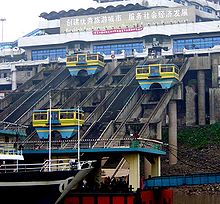
Worth seeing is the " Luohan Si ", a centuries-old temple that is hidden behind a passage, but its existence is already betrayed by the smell of incense sticks and paper money sellers outside its gates. The Arhat Hall is the interesting part of the temple, where the way leads counterclockwise along a rope barrier through a maze of 500 brightly painted, life-size statues of Buddhist saints. To the north of the temple there are two cable car stations that can be used to reach the northern and southern suburbs of Chongqing. Downhill from Luohan Si on Xinhua Street are the "Chaotianmen Docks". From the ticket offices with a viewing platform built in 1999 on a flood-proof embankment, you can see the Yangtze ferries, which are moored between the barges in the middle of the river.
Mao Zedong House
A house called Guijuan (Osmanthus Garden) is located on Zhongshan Si Street in the northwest of the city . This is where Mao Zedong lived when he stayed in Chongqing from August 12 to October 10, 1945 to celebrate the victory over Japan and to negotiate the double ten treaty with Chiang Kai-shek - the famous words on paper ensured an armistice between the Red Army and Kuomintang , which was short-lived.
Replicas of castles
The Chinese millionaire Liu had various European castles built in Chongqing that are freely accessible, including Windsor Castle and Neuschwanstein Castle .
Chaotianmen Yangtze Bridge
Below the mouth of the Jialing Jiang , the Yangtze River is spanned by the Chaotianmen-Yangtze Bridge , the arch bridge with the largest span in the world.
Rock sculptures by also
In the administrative area of the government city of Chongqing, 90 kilometers west of the city center, in the district ofAdd , lie the famous rock sculptures ofAdditional in the middle of a lush green landscape of hills and rice terraces . The sites have been on the UNESCO World Heritage List since 1999 and on the List of Monuments of the People's Republic of China since 1961 . The name for this means "big foot" and refers to a story according to which Buddha is said to have left a footprint on the nearby rock.
The stone carvings are extraordinary and comprise a total of around 50,000 pictures and figures in the niches, grottos and overhangs of the "Bei Shan" (north mountain) and the "Baoding Shan" (treasure chamber). Work began in 892 and took over 400 years to complete. Since then, thanks to an ingeniously integrated drainage system, the sculptures have not only defied the weather, but also the greed of foreign looters and local vandals due to their isolated location and strict laws.
Parks
A grassy peak with a pavilion in "Pipa Shan Park" is the highest point in the city at 220 meters. On many windless days, all you can see from there is the thick veil of smog that lies over Chongqing and through which the traffic noise and the quiet roar of construction machinery penetrate upwards. In the evenings, the air pollution is invisible and the hills and river are lit up by street lamps and industrial spotlights. Another green park in downtown Chongqing is "Eling Shan Park".
Natural monuments
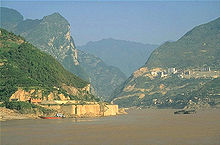
Baidicheng, in the administrative region of Chongqing, is the gateway to the Three Gorges , a well-known natural monument on the Yangtze . The first of the Three Gorges, the eight kilometer long Qutang Gorge , is extremely impressive. Its wild water, divided by sandbanks, was described by the poet Su Dongpo as early as the Song period (960–1279) as "a thousand seas flowing in one cup". Holes in the shape of a “Z” have been carved into the vertical rock walls, the so-called Meng Liang stairs. It leads to a platform halfway up where, according to legend, the Song general Yang Jiye was killed by traitors. When his bodyguard climbed the rock face to retrieve the head-stripped corpse, he was deceived by a monk, whom he later hung upside down on the rock face in revenge.
The second of the Three Gorges, the Wuxia Gorge , is located near Wushan , in the area of the government city of Chongqing. In the 45 kilometer long Witches Gorge , the goddess Yao Ji and her eleven sisters defeated some unruly river dragons before they froze into mountains themselves, but chose their location carefully so that they could safely guide the ships downstream. On the way, the rock inscription “Wuxia's peaks grow higher and higher” appears, which is attributed to the eminent strategist during the Three Kingdoms period (220–280 AD), Zhuge Liang - ambiguous words that unsettled an enemy general so much that he turned on the spot and fled with his army.
The city of Zigui, in the province of Hubei , is the gateway to the third of the Three Gorges, the Xiling Gorge , the longest and most dangerous gorge in the Yangtze. Western travelers touring this stretch of the river in the 19th century reported sandbanks emerging from the river as barriers, dangerous currents and threatening rocks that had to be kept on course by boat tugs with iron-clad bamboo poles as the ships crossed the river narrow gullies rocked into which no ray of sun could penetrate. The landscape has hardly changed since then, but the rocks, rapids and tugs no longer exist and the ships can navigate the passage without major difficulties.
Culinary specialties
There are numerous food stalls and takeaways in central Chongqing. The offer mostly consists of small dishes in the style of Sichuan cuisine, for example dumplings, pickled vegetables, fish, poultry or offal. A particular specialty are snake beans made from ginger, tiger skin pods, stewed frog, ribs and rice balls.
The Sichuan-style hot pot originates in Chongqing, and the locals do not renounce it even in hot summer. As a regional specialty, the raw ingredients are served on plates instead of skewers, with the pots being divided into different areas so that the dishes don't get mixed up. The hot pot stands on Bayi Street are the most popular.
shop
There are many department stores in the Jiefangbei district around the Liberation Monument, and their competition among them ensures low prices. The Chongqing Art Store on Minsheng Street and the Noble Shop Huipu on Renmin Street offer art. The Xinhua bookstore in the Minzu Road opposite the Post Office is one of the best in Chongqing. It offers a large selection of the usual titles from the 19th century, but also art volumes.
Economy and Infrastructure
economy
Chongqing is the center of an extremely industrialized region. Its location 2,400 kilometers upstream from Shanghai at the junction of the waterways from eastern China and the trade routes from Tibet and Myanmar gives the port city an exceptional economic potential. In the administrative area of the government-direct city of Chongqing there are extensive gas and coal deposits; Other mineral resources such as iron ore , barium , strontium and mercury are also of great importance.
With the relocation of the seat of government to Chongqing in 1938, the city's industrialization began. Numerous industrial plants were relocated here from the coast, including armaments factories. After the founding of the People's Republic in 1949, further extensive investments were made in the armaments sector. The automobile, motorcycle, electronics, aluminum, chemical, steel, food and textile industries are also important.
In 2005 the GDP was 306.91 billion yuan. Of this, the primary economic sector (raw material extraction) accounted for 46.342 billion yuan (15.1 percent), the secondary (raw material processing) 125.832 billion yuan (41.0 percent) and the tertiary sector (services) 134.736 billion yuan (43.9 percent) ). According to a study from 2014, Chongqing has a gross domestic product of 315.58 billion US dollars in purchasing power parity . In the ranking of the economically strongest metropolitan regions worldwide, it was ranked 33rd. Counted as an independent country, it would be among the 50 largest economies in the world. The GDP per capita is $ 10,516. Economically, the city is one of the fastest growing in the world.
The economy of Chongqing shows stable high growth, the standard of living of the population is growing rapidly, with household consumption expenditure increasing annually at constant prices. In the meantime there are hardly any market segments in the city that need to be liberalized in order to generate rapid, large and sustainable economic growth. There are some economic problem areas that require deep cuts to be resolved: for example, in non-privatized state-owned companies, some of which make heavy losses.
In a ranking of cities according to their quality of life, Chongqing ranked 140th out of 231 cities worldwide in 2018. In comparison with other Chinese cities, it was behind Shanghai (103rd place), Beijing and Guangzhou (both 109th place), Shenzhen (130th place) and Chengdu (133rd place) but still ahead of Xi'an (149th place) and Shenyang (157th place) ).
traffic
The city is an important transport hub with highways, railway lines, an intercity bus station, port, ferry terminal and an international airport.
Airport
The Chongqing Jiangbei International Airport is the main airport in the middle of China, it is located 21 kilometers northeast of the city center at an emerging development axis. It is served by a shuttle bus going to the CAAC office on Zhongshan San Street.
bus and train
The overland bus station is located at a traffic junction in the southwest of the city and offers connections to Chengdu, Leshan , Yibin , Zigong andtons , among others . Minibuses run from the bus station to the Chaotianmen Docks.
Chongqing's train station is right next to the interurban bus station. Trains run to Xi'an and Zunyi , and there are connections to Beijing, Chengdu, Guangzhou, Guiyang , Shanghai and Wuhan . The ferry terminal is on the eastern tip of the peninsula at the end of Binjiang Street. Every day, a hovercraft sails to Yichang , which passes the Three Gorges Dam.
Public transport
For several years only diesel-powered buses were used as local public transport . Trolleybuses ran in Chongqing between December 24, 1955 and May 23, 2004. Another way to get around the city is to use the numerous taxis.
Chongqing has had a local rail network since January 2005 in the form of the Chongqing Rail Transit . It consists of a semi-mounted monorail with currently two lines (2 and 3) and a classic subway with six lines (1, 4, 5, 6, and 10 and a ring line).
The cable car station for trips across the Jinling River to the northern suburbs of Chongqing is located on Cangbai Street; a second cable car runs from Xinhua Street across the Yangtze River to the southern suburbs. A special feature are the four cabins of an inclined elevator and another funicular , which effortlessly overcome the steep height difference for passengers from the river port level to the city.
International freight transport
Since the successful test run on March 30, 2012, the Trans-Eurasia-Express freight train has been connecting the Ruhr area ( Duisburg ) with Chongqing; The Yuxinou freight train has been operating officially since August 31, 2012 , also between Chongqing and Duisburg; Since October there has been a weekly connection to Mannheim .
education
The city has numerous universities, colleges and technical schools, research institutes and libraries. The two most important universities are:
- Chongqing University ( 重庆 大学 ), opened in 1929;
- University of Southwest China ( 西南 大学 ), opened in 1906;
Other educational institutions:
- Chongqing University of Architecture ( 重庆 建筑 大学 );
- Chongqing Telecommunications Institute ( 重庆 通信 学院 );
- Chongqing Three Gorges College ( 重庆 三峡 学院 );
- Third Military Medical University of the Chinese People's Liberation Army ( 中国人民解放军 第三 军医 大学 );
- Sichuan Foreign Language University ( 四川 外国语 大学 ), opened in 1950;
- Sichuan College of Arts ( 四川 美术 学院 );
- Chongqing University of Science and Art ( 重庆 文理 学院 );
- Jiaotong University Chongqing ( 重庆 交通 大学 );
- Chongqing Medical University ( 重庆 医科大学 );
- Chongqing Pedagogical University ( 重庆 师范大学 );
- Yangtze Pedagogical University ( 长江 师范 学院 );
- Chongqing University of Technology ( 重庆 理工 大学 );
- Chongqing University of Industry and Commerce ( 重庆 工商 大学 );
- University of Logistics and Engineering of the China People's Liberation Army ( 中国人民解放军 后勤 工程 学院 );
- Southwest China University of Political Science and Law ( 西南 政法 大学 );
- Chongqing University of Post and Telecommunications ( 重庆 邮电 大学 );
- University of Science and Technology Chongqing ( 重庆 科技 学院 );
- Second Chongqing University of Education ( 重庆 第二 师范 学院 ).
Structural urban development
With the status of the city directly under the government (1997) and the boost from the "Great Western Development Strategy" funded by Beijing, previously unheard of funds have flowed into the infrastructure of the metropolis. It also attracts with tax discounts for company settlements and has a disproportionate influx of workers from the rural hinterland. Since the world's largest power plant in the administrative area of Chongqing went into operation, bottlenecks in the energy supply have become a thing of the past, in contrast to large parts of eastern and southern China.
Chongqing is subject to profound urban renewal and rapid urban expansion; the state planning and building regulations hardly allow any contradiction. Downtown on the peninsula resembles Manhattan , the tallest skyscraper is the Chongqing World Financial Center at 339 m. The Chongqing IFS T1 measures 316 m. Chongqing Corporate Avenue 1 with a planned height of 468 meters is under construction . Another spectacular construction project is Raffles City Chongqing , which was only completed in autumn 2019. The construction devised by the architect Mosche Safdie connects the 4 tallest of the individual buildings with a 300 meter long glass bridge called "Crystal" and is located directly on the old market of Chaotianmen, at the confluence of the Yangtze and Jialing rivers.
Despite the difficult geological conditions, every square meter of the ground is used, and older buildings are constantly being demolished to make room for ever higher things. The development in the suburbs in particular is remarkable: many buildings older than 1980 were demolished, the areas straightened and mostly multi-storey new buildings. The suburbs certainly follow a pattern of modern urbanization, each quarter is given a certain independence with school, social, shopping and leisure facilities. The hilly areas were developed with a grid of generous expressways and even with the service roads, the planners assume that the population will soon have a motor vehicle density comparable to, for example, Japan or South Korea.
The new suburbs enclose the core city in all directions, and the smaller dams and ponds that were once built for terraced farming are often integrated into the new development areas. The first villa areas and upscale residential complexes for a growing middle class are also being built here: almost 60 percent of the businesses are now privately owned. Occasionally, based on the American model, villa complexes are also emerging in connection with golf courses, capitalism based on the Chinese model is spreading.
sons and daughters of the town
- Zou Rong (1885–1905), democratic revolutionary and anarchist
- Sun Yu (1900–1990), film director
- Zhao Shiyan (1901–1927), revolutionary and founding member of the Chinese Communist Party
- Tung-Hua Lin (1911-2007), Sino-American engineer
- Lucien Bodard (1914–1998), French journalist, writer and actor
- Xia Peisu (1923–2014), computer scientist and university professor
- Ke-Jian A (* 1933), violinist, music teacher and composer
- Adrian Hsia (1938–2010), literary scholar, German and English studies specialist
- Nan Lin (* 1938), American sociologist
- John Tu (* 1940), Sino-American businessman and President of Kingston Technology
- Dai Qing (* 1941), journalist and environmental activist
- Zhang Xiguo (Chang Hsi-kuo) (* 1944), Chinese-American scientist and author
- Gao Yu (* 1944), journalist and critic of the regime
- Virginia Man-Yee Lee (* 1945), American neuropathologist and immunobiologist
- Wang Hongju (* 1945), politician
- Wu Ching-Kuo (* 1946), Taiwanese sports official, engineer and entrepreneur
- Zheng Yi (born 1947), author
- Jia Daqun (* 1955), composer
- Xu Bing (* 1955), concept artist and university professor
- Fu Wenjun (* 1955), artist and photographer
- Guo Wenjing (* 1956), composer
- Liu Jiayi (* 1956), politician
- Liu Xiaofeng (* 1956), philosopher
- Tang Renjian (born 1962), politician
- Ran Yunfei (* 1965), blogger and dissident
- Hong Chen (* 1966), writer and professor of journalism
- Chen Lin (1970-2009), singer
- Xie Nanxing (born 1970), artist
- Zhang Jin (* 1974), martial artist and actor
- Chen Kun (* 1976), singer and actor
- Zhang Zhong (* 1978), chess player
- Jiang Xuelian (* 1979), badminton player
- Pi Hongyan (* 1979), Sino-French badminton player
- Tian Liang (* 1979), water diver
- Chenyang Xu (* 1981), mathematician
- Li Yundi (* 1982), pianist
- Tian Tian (* 1983), chess player
- Zhang Yawen (born 1983), badminton player
- Domee Shi (* 1989), Chinese-Canadian storyboard artist
- Shi Tingmao (* 1991), water diver
- Li Xuerui (* 1991), badminton player
- Tan Zhongyi (* 1991), chess player
- Xu Xiaolong (* 1992), triple jumper
- Yuan Xinyue (* 1996), volleyball player
- Lei Tingjie (* 1997), chess grandmaster
- Wang Junkai (* 1999), actor and singer
- The couple Wu Ping and Yang Wu , whose steadfast refusal to sell his property below market value, made in China for attention.
literature
- Joshua H. Howard: Workers at War . Stanford University Press, 2004, ISBN 0-8047-4896-9 .
- Ursula Panhans-Bühler: Chilies from Chongqing . Stroemfeld-Verlag, 2001, ISBN 3-87877-776-0 .
- Lutz Simon: One time just Chongqing - Wuhan. With the transport ship on the Yangtze. Verlag Lutz Simon, Frankfurt am Main 2000, ISBN 3-9800487-5-6 .
- Mao Zedong: About the Chungking negotiations . Verlag für Fremdsprachige Literatur, 1961, B0000BLB4S
Web links
- Chongqing City Government (Chinese)
- Facts and Figures ( Memento from January 21, 2008 in the Internet Archive ) (German)
- Information about Chongqing (German)
- Chongqing Life Guide (English)
- Chongqing on the Yangtze River (very instructive on the newer development and the 3 Gorges Reservoir; German)
Items:
- Big, Gritty Chongqing, City of 12 Million, Is China's Model for Future . In: New York Times , June 1, 2007
- Of millionaires and mafiosi . In: Friday , December 12, 2009; “Chongqing is a metropolis in western China and was in the hands of organized crime. Until the fight started. "
Pictures and videos
- Landmarks in Chongqing , January 2013
- Jonathan Watts: 24 hours in Chongqing . In: The Guardian , April 8, 2006, MP4 video, 09:19 min., 25.5 MB; with report
Individual evidence
- ↑ Mengjie: Tang Liangzhi elected Chongqing mayor. Xinhua , January 31, 2018, accessed December 27, 2018 .
- ↑ China Statistical Yearbook 2017: Population at Year-end by Region. National Bureau of Statistics of China, 2017, accessed August 21, 2018 .
- ↑ a b Chongqing Statistical Yearbook 2017: Households and Population by Region (2016). Chongqing Municipal Bureau of Statistics & NBS Survey Office, 2017, accessed August 21, 2018 .
- ↑ Old version from www.liangjiang.gov.cn on archive.org ( Memento from March 28, 2013 in the Internet Archive )
- ↑ Old version from www.liangjiang.gov.cn on archive.org ( Memento from March 25, 2013 in the Internet Archive )
- ↑ Data from the National Bureau of Statistics, China, at Geohive ( Memento from September 24, 2015 in the Internet Archive )
- ↑ Mercury in drought-hit Chongqing hits 44.5 degrees Celsius . ( Memento of January 12, 2008 in the Internet Archive ) In: Shenzhen Daily
- ↑ Rainstorm reset Meteorological Records China.org
- ↑ The Curse of Evil Deeds. (No longer available online.) In: sopos.org. Archived from the original on November 28, 2016 ; accessed on November 26, 2016 : "The bombing of Chinese cities such as Shanghai, Nanking and Chongqing killed around 350,000 people between 1931 and 1945." Info: The archive link was inserted automatically and has not yet been checked. Please check the original and archive link according to the instructions and then remove this notice.
- ↑ "Kill all, burn all, loot all". In: welt.de. Retrieved November 26, 2016 .
- ↑ Russell D. Buhite: Patrick J. Hurley and American Foreign Policy. Cornell University Press, 1973, pp. 82 f.
- ^ Changing migration patterns - Welcome home . In: The Economist , February 25, 2012
- ↑ World Urbanization Prospects - Population Division - United Nations. Retrieved July 23, 2018 .
- ↑ Two municipalities get new leaders ( Memento of the original from November 21, 2012 in the Internet Archive ) Info: The archive link was inserted automatically and has not yet been checked. Please check the original and archive link according to the instructions and then remove this notice. China Daily, November 20, 2012 (accessed November 20, 2012)
- ^ A b Chongqing Municipal Government
- ^ The Art Newspaper ( Memento of January 24, 2017 in the Internet Archive ) accessed on January 12, 2017.
- ^ Neuschwanstein in China: Mr. Liu collects locks. Spiegel online, November 16, 2013, accessed December 3, 2013 .
- ↑ China's SW municipality posts double-digit GDP growth in 2005 . In: People's Daily
- ^ Alan Berube, Jesus Leal Trujillo, Tao Ran, and Joseph Parilla: Global Metro Monitor . In: Brookings . January 22, 2015 ( brookings.edu [accessed July 19, 2018]).
- ↑ Mercer's 2018 Quality of Living Rankings. Retrieved August 18, 2018 .
- ↑ Press release: Trans-Eurasia-Logistic: “Regular train connection between Chongqing and Duisburg” , March 30, 2012
- ↑ 11,200-kilometer route: A freight train is now traveling from Mannheim to China . In: FAZ.NET . ISSN 0174-4909 ( faz.net [accessed October 25, 2018]).
- ^ Nisha Ramchandi: Shopping mall Raffles City Chongqing in China officially launched. In: The Business Times. October 16, 2019, Retrieved November 14, 2019 (American English).
- ↑ Kungfu master gives way to excavators . In: FAZ , April 4, 2007

